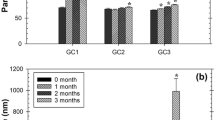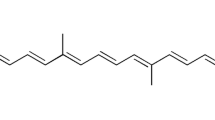Abstract
Exogenously supplied alpha-lipoic acid (LA) has proven to be effective as an antioxidant. In an effort to develop a water-soluble formulation for topical administration, LA was formulated in the form of solid lipid nanoparticles (SLN), nanostructure lipid carriers (NLC), and nanoemulsion (NE) and characterized in terms of physical and biological properties. Mean particle size of 113, 110, and 121 nm were obtained for NE, NLC, and SLN, respectively, with narrow size distribution. Zeta potential was approximately in the range of −25 to −40 mV. Disc and spherical structures of nanoparticles were observed by cryo-scanning electron microscopy. Entrapment efficiency of LA in three formulations was found to be more than 70%. After 120 days of storage at 25°C, physical stability of all formulations remained unchanged whereas the entrapment efficiency of SLN and NLC could be maintained, suggesting relative long-term stability. Prolonged release of LA formulation following the Higuchi model was found where a faster release was observed from NE compared with that of SLN and NLC. More than 80% of cell survivals were found up to 1 μM of LA concentrations. Antioxidant activity analysis demonstrated that all LA-loaded formulations expressed antioxidant activity at a similar magnitude as pure LA. These results suggest that chosen compositions of lipid nanoparticles play an important role on drug loading, stability, and biological activity of nanoparticles. Both SLN and NLC demonstrated their potential as alternative carriers for aqueous topical administration of LA.







Similar content being viewed by others
Abbreviations
- DHLA:
-
dihydrolipoic acid
- LA:
-
alpha-lipoic acid
- NE:
-
nanoemulsion
- NLC:
-
nanostructure lipid carriers
- SLN:
-
solid lipid nanoparticles
- ROS:
-
reactive oxygen species
- Z :
-
ave particle diameter
- MW:
-
molecular weight
- PDI:
-
polydispersity index
- ZP:
-
zeta potential
- PCS:
-
photon correlation spectroscopy
- SEM:
-
scanning electron microscopy
- TEM:
-
transmission electron microscope
- DSC:
-
differential scanning calorimetry
- ΔH :
-
melting enthalpy
- RI:
-
recrystallization index
- HPLC:
-
high-performance liquid chromatography
- EE:
-
entrapment efficiency
- FBS:
-
fetal bovine serum
- NHF:
-
human foreskin fibroblast
- DMEM:
-
Dulbecco’s modified Eagle’s medium
- MTT:
-
3-(4,5-dimethylthiazol-2-yl)-2,5-diphenyl-tetrazolium bromide
- PBS:
-
phosphate buffer saline
- SD:
-
standard deviation
- p value:
-
probability value
References
U. Cakatay, A. Telci, R. Kayali, A. Sivas, and T. Akcay. Effect of lipoic acid supplementation on oxidative protein damage in the streptozotocin-diabetic rat. Res. Exp. Med. (Berl). 199:243–251 (2000).
Y. Dincer, A. Telci, R. Kayal, C. Yılmazia, U. Cakatay, and T. Akcay. Effect of a-lipoic acid on lipid peroxidation and antioxidant enzyme activities in diabetic rats. Clin. Exp. Pharmacol. Physiol. 29:281–284 (2002).
M. A. Lovell, C. Xie, S. Xiong, and W. R. Markesbery. Protection against amyloid b peptide and iron/hydrogen peroxide toxicity by a-lipoic acid. J. Alzheimer Dis. 5:229–239 (2003).
G. H. Marracci, G. P. McKeon, W. E. Marquardt, R. W. Winter, M. K. Riscoe, and D. N. Bourdette. α-Lipoic acid inhibits human T cell migration: implications for multiple sclerosis. J. Neurosci. Res. 78:362–370 (2004).
A. R. Smith, S. V. Shenvi, M. Widlansky, J. H. Suh, and T. M. Hagen. Lipoic acid as a potential therapy for chronic diseases associated with oxidative stress. Curr. Med. Chem. 11:1135–1146 (2004).
A. Baur, T. Harrer, M. Peukert, G. Jahn, J. R. Kalden, and B. Fleckenstein. Alpha-lipoic acid is an effective inhibitor of human immuno-deficiency virus (HIV-1) replication. J. Mol. Med. 69:722–724 (1991).
U. Cakatay. Pro-oxidant actions of a-lipoic acid and dihydrolipoic acid. Med. Hypotheses. 66:110–117 (2006).
A. Bliska, and L. Wlodek. Lipoic acid—the drug of the future? Pharmacol. Rep. 57:570–577 (2005).
L. Packer. α-Lipoic acid: a metabolic antioxidant, which regulates NF-κВ signal transduction and protects against oxidative injury. Drug Metab. Rev. 30:245–275 (1998).
D. Ziegler, and F. A. Gries. Alpha-lipoic acid in the treatment of diabetic peripheral and cardiac autonomic neuropathy. Diabetes. 46:S62–S66 (1997).
S. D. Wollin, and P. J. Jones. Alpha-lipoic acid and cardiovascular disease. J. Nutr. 133:3327–3330 (2003).
J. Fuchs, and R. Milbradt. Antioxidant inhibition of skin inflammation induced by reactive oxidants: Evaluation of the redox couple dihydrolipoate/lipoate. Skin Pharmacol. 7:278–284 (1994).
M. Podda, M. Rallis, M. G. Cuber, L. Packer, and H. Maibachl. Kinetic study of cutaneous and subcutaneous distribution following topical application of [7,8J4C] rac-cx-lipoic acid onto hairless mice. Biochem. Pharmacol. 52:627–633 (1996).
H. Beitner. Randomized, placebo-controlled, double blind study on the clinical efficacy of a cream containing 5% α-lipoic acid related to photoageing of facial skin. Br. J. Dermatol. 149:841–849 (2003).
R. H. Müller and J. S. Lucks. Medication vehicles made of solid lipid particles (solid lipid nanospheres—SLN). Eur. Patent 0605497 (1996).
R. H. Müller, K. Mäder, and S. Gohla. Solid lipid nanoparticles (SLN) for controlled drug delivery—a review of the state of the art. Eur. J. Pharm. Biopharm. 50:161–177 (2000).
R. H. Müller, and C. M. Keck. Challenges and solutions for the delivery of biotech drugs—a review of drug nanocrystal technology and lipid nanoparticles. J. Biotech. 113:151–170 (2004).
E. Ugazio, R. Cavalli, and M. R. Gasco. Incorporation of cyclosporin A in solid lipid nanoparticles (SLN). Int. J. Pharm. 241:341–344 (2002).
S. A. Wissing, and R. H. Müller. Cosmetic applications for solid lipid nanoparticles (SLN). Int. J. Pharm. 254:65–68 (2003).
S. A. Wissing, and R. H. Müller. The influence of solid lipid nanoparticles on skin hydration and viscoelasticity—in vivo study. Int. J. Pharm. 56:67–72 (2003).
K. Jores, W. Mehnert, M. Drechsler, H. Bunjes, C. Johann, and K. Mäder. Investigations on the structure of solid lipid nanoparticles (SLNs) and oil-loaded solid lipid nanoparticles by photon correlation spectroscopy, field-flow fractionation and transmission electron microscopy. J. Controlled Release. 95:217–227 (2004).
W. Mehnert, and K. Mäder. Solid lipid nanoparticles: production, characterization and applications. Adv. Drug. Deliv. Rev. 47:165–196 (2001).
V. Teeranachaideekul, E. B. Souto, V. B. Junyaprasert, and R. H. Müller. Cetyl palmitate-based NLC for topical delivery of coenzyme Q10—development, physicochemical characterization and in vitro release studies. Eur. J. Pharm. Biopharm. 67:141–148 (2007).
C. Freitas, and R. H. Müller. Correlation between long-term stability of solid lipid nanoparticles (SLN™) and crystallinity of the lipid phase. Eur. J. Pharm. Sci. 47:125–132 (1999).
A. Ernst, A. Stolzing, G. Sandig, and T. Grune. Antioxidants effectively prevent oxidation-induced protein damage in OLN 93 cells. Arch. Biochem. Biophys. 421:54–60 (2004).
M. A. Schubert, and C. C. Müller-Goymann. Characterisation of surface-modified solid lipid nanoparticles (SLN): influence of lecithin and nonionic emulsifier. Eur. J. Pharm. Biopharm. 61:77–86 (2005).
A. Saupe, K. C. Gordon, and T. Rades. Structural investigations on nanoemulsions, solid lipid nanoparticles and nanostructured lipid carriers by cryo-field emission scanning electron microscopy and Raman spectroscopy. Int. J. Pharm. 314:56–62 (2006).
W. Tiyaboonchai, W. Tungpradit, and P. Plianbangchang. Formulation and characterization of curcuminoids loaded solid lipid nanoparticles. Int. J. Pharm. 337:299–306 (2007).
H. Bunjes, K. Westesen, and M. H. J. Koch. Crystallization tendency and polymorphic transitions in triglyceride nanoparticles. Int. J. Pharm. 129:159–173 (1996).
A. Saupe, S. A. Wissing, A. Lenk, C. Schmidt, and R. H. Müller. Solid lipid nanoparticles (SLN) and nanostructured lipid carriers (NLC)—structural investigations on two different carrier systems. Biomedical Mater. 15:393–402 (2005).
V. Jenning, A. F. Thünemann, and S. H. Gohla. Characterisation of a novel solid lipid nanoparticle carrier system based on binary mixtures of liquid and solid lipids. Int. J. Pharm. 199:167–177 (2000).
V. Jenning, and S. Gohla. Comparison of wax and glyceride solid lipid nanoparticles (SLN®). Int. J. Pharm. 196:219–222 (2000).
V. Jenning, and S. H. Gohla. Encapsulation of retinoids in solid lipid nanoparticles (SLN). J. Microencapsul. 18:149–158 (2001).
E. B. Souto, S. A. Wissing, C. M. Barbosa, and R. H. Müller. Development of a controlled release formulation based on SLN and NLC for topical clotrimazole delivery. Int. J. Pharm. 278:71–77 (2004).
A. Z. Mühlen, C. Schwarz, and W. Mehnert. Solid lipid nanoparticles (SLN) for controlled drug delivery—drug release and release mechanism. Eur. J. Pharm. Biopharm. 45:149–155 (1998).
R. H. Müller, D. Rühl, S. Runge, K. Schulze-Forster, and W. Mehnert. Cytotoxicity of solid lipid nanoparticles as a function of the lipid matrix and the surfactant. Pharm. Res. 14:458–462 (1997).
Acknowledgements
This research was financially supported by the National Nanotechnology Center (NANOTEC), Thailand (research grant number B22 CR0102).
Author information
Authors and Affiliations
Corresponding author
Rights and permissions
About this article
Cite this article
Ruktanonchai, U., Bejrapha, P., Sakulkhu, U. et al. Physicochemical Characteristics, Cytotoxicity, and Antioxidant Activity of Three Lipid Nanoparticulate Formulations of Alpha-lipoic Acid. AAPS PharmSciTech 10, 227–234 (2009). https://doi.org/10.1208/s12249-009-9193-6
Received:
Accepted:
Published:
Issue Date:
DOI: https://doi.org/10.1208/s12249-009-9193-6




